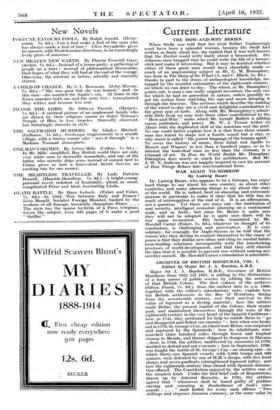Current Literature
THE 1-133W-AND,VVHV -SERIES
When Stella was told that her rival 'talker Vanliomrigh must have been a splendid woman, because Dr. Sniff had written so finely about her, she replied that it Was well known that the Doctor could 'write- finely about a broomstick. Dr( Johnson once bragged that he could write the life of a brooM stick and make it interesting. But it may be doubted whether either of these great men would have- cheerfully made so much of an unpromising subject as Mi. G. M. Boumphrey has done in The Story of the Wheel (A: and C. Black; 2s. lid.)-- - thanks in part to the stores of archaeological knowledge, uni- tapped by the Scornful rationalists of the eighteenth century. on which we can draw to-day. The wheel, as Mr. Bournphrey points out, is man's one really original invention, the only one for which he had no precedent in nature, unless. possillly he got his notion from witching the sun-and moon hdoping it through the heavens. Thesections which describe the making of the wheel to-day are a .vivid and delightful contribution to the great epic of tools. Along with Mr. Boumphrey's_ndmir- able little book we may note three other contributions to the " How-and-Why " series which Mr. Gerald Aullett is editing (same publishers and price). Mr. W. J. Turner writes on Music with the duplicated skill of the musician and the poet: No one could better explain how it is that from three sounds man has learnt to shape not a fourth sound but a star, or why Music is called" the purest language of the human spirit." To cover the history of music, from 'Jubal and Apollo to Mozart and Wagner, in less than a hundred pages, so as to Interest the tone-deaf man no less than the virtuoso; is a triumph of art. In How the World Builds Mr. Humphrey Pakington does nearly as much for architecture. But Mr. J. W. N. Sullivan was not happily inspired to cast his account of How Things Behave into conversational form.








































 Previous page
Previous page